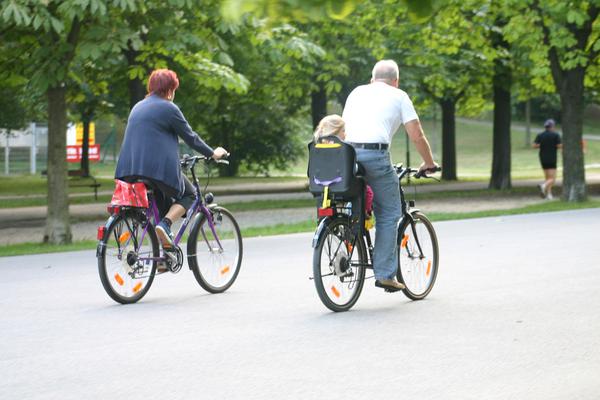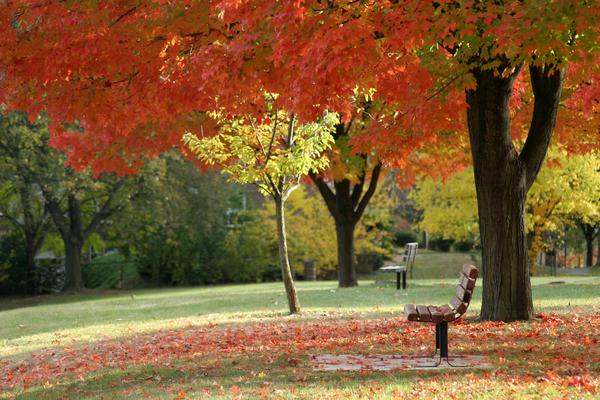Put Trees to Work in Your Community
Urban trees improve our lives by benefiting our economy, our environment, and our health. You can improve your community by being proactive, developing green infrastructure, and putting trees to work for you. Thriving communities that adopt community tree programs improve the economic, social, and environmental wellbeing of their citizens. Green spaces attract people, commerce, and tourism. Conservation of urban forests and green space is a low-cost, multiple-benefit community investment.
Trees Benefit the Economy
By controlling erosion and reducing urban runoff, trees help communities to save money on storm damage repair. They lower temperatures through shade and evapotranspiration, which reduces energy needs and costs. Trees and the atmosphere they create raise the value of homes and attract businesses and tourism, thereby increasing tax revenue.
A tree-filled community has increased
- income,
- jobs,
- worker productivity, and
- customers.
- Trees in the landscape lead to higher home values and rapid real estate sales, which raise tax revenue.
- Trees reduce air pollution. The American Forest valued reductions in air pollution costs because of trees in Mecklenburg County at $40 million.
- Trees control stormwater costs. For example, researchers estimate that in Charlotte, North Carolina's largest city, runoff control from trees saved $2.8 billion in water storage unit costs.
- Shade from properly placed trees can reduce cooling costs for a business or home up to 50 percent.
Sources
Coder, K.D. Identified Benefits of Community Trees and Forests.
Rosenfeld, A H., J .J. Romm, H. Akbari, M. Pomerantz & H. G. Taha. 1996. Policies to reduce heat islands: magnitudes of benefits and incentives to achieve them. In Proceedings of the 1996 ACEEE Summer Study on Energy Efficiency in Buildings (Vol. 9), p.177. Pacific Grove, CA: ACEEE.
American Forests. 2010. Urban Ecosystem Analysis—Mecklenburg County, North Carolina. www.americanforests.org
Trees Clean the Air and Water
Trees remove harmful gases that contribute to smog, acid rain, and the greenhouse effect. They capture sediment and toxins that lower water quality, which reduces the need for costly stormwater control measures.
- Trees remove harmful gases, such as nitrogen oxides, sulfur dioxides, carbon monoxide, carbon dioxide, and ozone. For example, trees remove 14.9 million pounds of air pollutants each year in Mecklenburg County, North Carolina.
- Street trees capture toxic heavy metals, such as cadmium, chromium, nickel, and lead.
- Urban trees reduce the “heat island effect,” cooling our cities by as much as 9ºF.
- One tree cools as much as five air conditioners running 20 hours a day.
Sources
Akbari, H., S. Davis, S. Dorsano, J. Huang, S. Winnett (Eds.). 1993. Cooling our communities: A guidebook on tree planting and light-colored surfacing. EPA Publication No. PM-221. Washington, DC: U.S. EPA.
American Forests. 2010. Urban Ecosystem Analysis—Mecklenburg County. www.americanforests.org
Trees Foster Healthy Communities
By creating safe, shaded open spaces for children to play and adults to congregate, trees enrich our lives. They reduce stress by filtering unwanted noise and replacing it with bird songs and rustling leaves. Domestic abuse, including child abuse, is lower in homes near trees.
Trees encourage people to
- congregate,
- conduct business,
- exercise, and
- interact.
- Hospital patients with views of trees have fewer complications, less need for painkillers, and shorter stays; prisoners have fewer stress syndromes.
- Increased green space has been linked with decreased strain on police and emergency services.
Sources
Prow, T. 1999. The Power of Trees. The Illinois Steward Magazine (Vol. 7, No 4).
The National Arbor Day Foundation. The Value of Trees to a Community. www.arborday.org/trees/benefits.cfm
Trees Invest in a Better Tomorrow!
Your community can afford urban forestry because trees provide many benefits and people support conservation. In the past decade, American voters have passed more than 1,200 bond referenda amounting to more than $29 billion dollars for conservation with a 78 percent approval rating. Invest in urban forestry and collect growing returns.
Contact one of the organizations below for more information:
Extension Forestry at North Carolina State University
International Society of Arboriculture
Publication date: April 3, 2020
Reviewed/Revised: Feb. 19, 2025
AG-677
N.C. Cooperative Extension prohibits discrimination and harassment regardless of age, color, disability, family and marital status, gender identity, national origin, political beliefs, race, religion, sex (including pregnancy), sexual orientation and veteran status.



